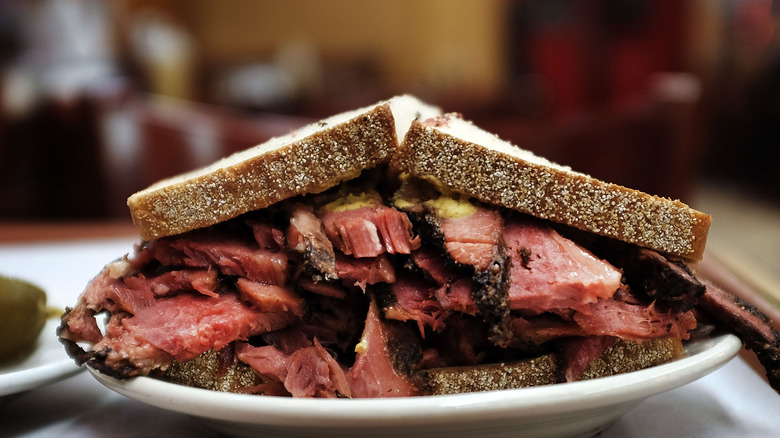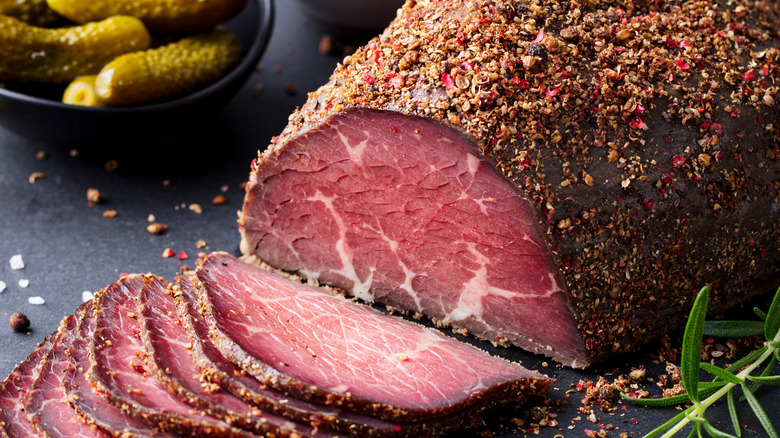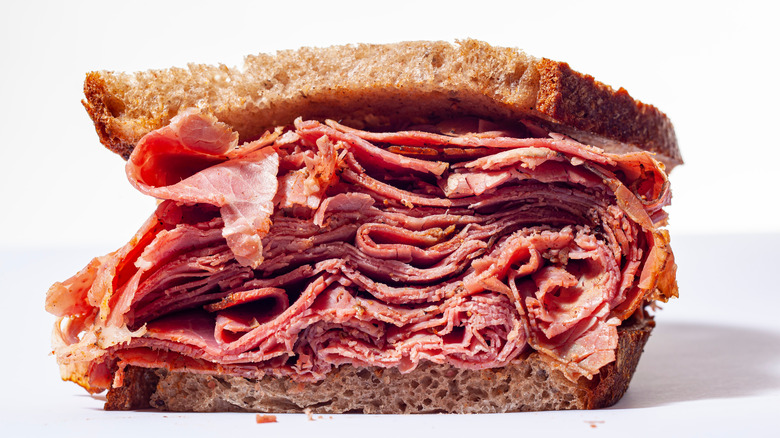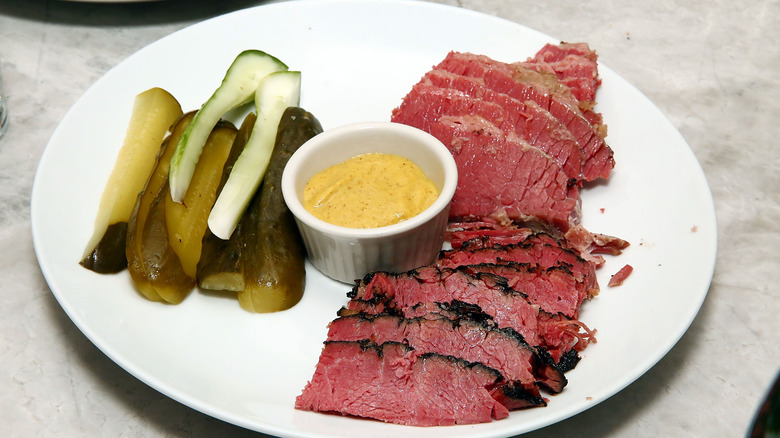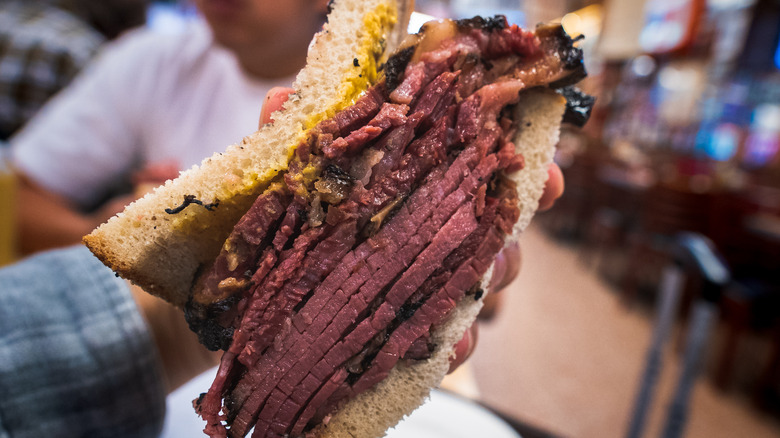How Pastrami Became An NYC Classic
A cherished food redolent with rich, storied history and cultural significance, pastrami is an icon unto itself. The piece de resistance in Jewish delis and sandwiches throughout the world, the prized meat is taken very seriously by its biggest fans, and its place in NYC lore is paramount. It didn't just pop up in the Big Apple, though — so where and how did pastrami come to be? What led to its creation and how was it first used? And most importantly, how did this meat become a NY staple?
Serious Eats notes that sometime between 1881 and 1914 "some 75,000 Jews left Romania and settled in New York City." While the actual American origins of pastrami is hotly contested, it began to grow in popularity in the late 1800s in NYC. Serious Eats also delves into the notion that not all pastrami was strictly sold in NYC — it lists pastrami-like products being sold in New Mexico and Georgia, too.
Untapped Cities states that a plethora of delis were opened in the late 1800s, which was an especially appealing and attractive career plan for new immigrants of the era. The term "deli" hails from the term delikatessans, which were then known as "Jewish-German gourmet food stores." Some also note that "delicatessen" actually comes from the roots of the Latin word for "luxurious," which could capture the essence of pastrami sandwiches "piled mile high" and dripping in mustard.
The origins of pastrami
According to 10best, most pastrami made in Romania to this day is primarily made with sheep or lamb meat. It's also typically served as an entree accompanied by vegetables or salad. When served as a sandwich, it's referred to as "American style" by many Romanians. Spoon University states that pastrami began as a means of preserving expensive meats before the creation of modern refrigeration. Soon notes that the original pastrami was a relic delivered to America by "Jewish immigrants from Berssarabia," which was "a historical region residing in parts of present-day Moldova, Ukraine, and Romania." Spoon University also notes that the first pastrami possibly used goose breast, but began to be made with beef once emigrating to America.
Phaidon reports that a confluence of factors helped to bring pastrami to the status symbol that it is now. Influenced by the book "Signature Dishes that Matter," the piece states that the abundance of beef at the time is one of the biggest reasons pastrami came to be. As Jewish and Yiddish immigrants thought about how to handle the surplus of beef, historic techniques were used in order to best cure the meat, which resulted in the pastrami spice blends and traditional cooking methods that are still used today.
The iconic pastrami sandwich
Phaidon notes that the name pastrami actually hails from the Turkish word 'bisturma," and that the juxtaposition between fatty, juicy pieces and lean, thin pieces were always a standout in the best kinds of pastrami sandwiches — along with the bread and accouterments, of course. The confluence of Jewish communities, with German contributions such as rye bread, began to blend in a manner that was indicative of the cultural status of the times.
In addition to pastrami, these delis often served sausages, dill pickles, and specialty baked goods. A popular condiment found in these delis was mustard, which many slathered with reckless abandon on pastrami sandwiches.
Technically, pastrami is "smoked and seasoned corned beef," which was already a part of the American diet. There was a rich, delectable essence associated with these deli sandwiches — piled high with fatty, delicious meats, they were by no means a light meal, but the sheer indulgence was something that people craved, just as they do now.
The ups and downs of pastrami
Untapped Cities notes that the majority of Jewish delis opening in the early 1900s were popping up within the Theater District, where Jewish people could "[rely] on the deli as a social space to avoid anti-Semitism prevalent in the 1910s and 1920s where they could also immerse themselves in celebrity culture." During the Great Depression, Jewish delis became more prevalent and served as a beacon of comfort and stability in a landscape that was otherwise disintegrating. The Tallahassee Democrat notes that there were reportedly 1550 kosher delis through NYC in the 1930s — now that's impressive.
World War II, however, "took a toll on these delis," but the Jewish communities of the time would rally together to support each other's delis and businesses. Untapped Cities notes that the 70s and 80s were also a challenging time, as diet culture boomed, the fat-and-sodium laden meat sandwiches began to fall by the wayside. In recent decades, though, pastrami has made its way back into the spotlight, bolstered by iconic portrayals within culture and media, such as in "When Harry Met Sally" and more recently, "The Marvelous Miss Maisel."
CNN notes that the pandemic caused another dent in the ongoing plight of Jewish delis, bringing the total number of NYC Jewish delis presently to about 20 only, some of which you may find on Mashed's list of best delis in the U.S.
The future of pastrami
Nowadays, pastrami cookery isn't limited to just beef and sheep. TASTE notes that many modern chefs are preparing foods in a pastrami style, imbuing dissimilar ingredients with familiar nostalgic flavors. Many chefs are even making pastrami-flavored seafood such as salmon and vegetarian dishes, like beets.
As long as the pastrami flavor remains consistent, almost anything can be prepared in pastrami style. While meats are often smoked with the seasoning adhering to the exterior, there are no rules limiting you from sprinkling pastrami spice over foods that wouldn't necessarily come to mind. TASTE lists popcorn, mango, and even yogurt as possible pastrami alternatives. The outlet shares that the seasoning itself contains coriander, pepper, paprika, salt, brown sugar, garlic powder, and yellow mustard seeds — making it incredibly versatile, while still retaining the roots of its historic origins.
There is a clear disparity between the abundance and overtness of the iconic deli sandwiches of today and the food that was consumed at these same eateries in the early 1900s. The towering sandwiches now revered as nostalgic and iconic were a fully American experience in excess — the perfect combination of Eastern European ingenuity and American indulgence, and a landmark piece of food culture that bridges the sandwich meat of today with that of yore.
